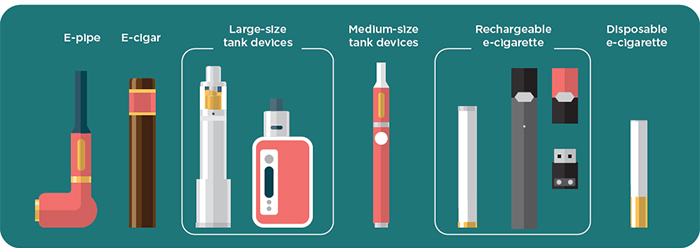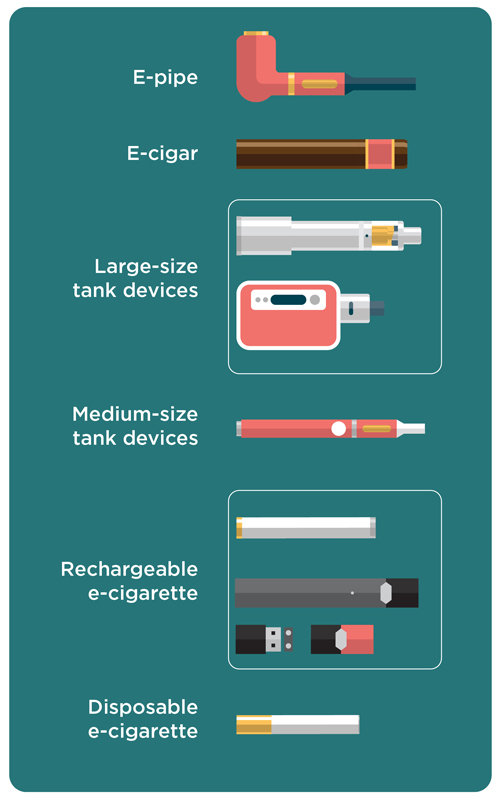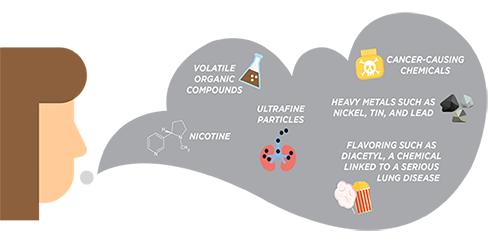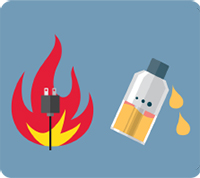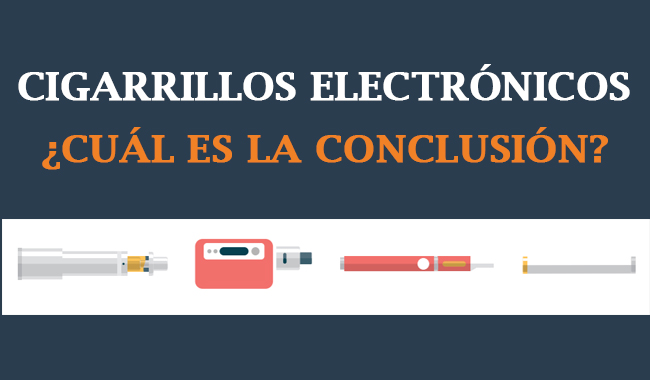About Electronic Cigarettes (E-Cigarettes)
What's the bottom line?
- E-cigarettes have the potential to benefit adult smokers who are not pregnant if used as a complete substitute for regular cigarettes and other smoked tobacco products.
- E-cigarettes are not safe for youth, young adults, pregnant women, or adults who do not currently use tobacco products.
- While e-cigarettes have the potential to benefit some people and harm others, scientists still have a lot to learn about whether e-cigarettes are effective for quitting smoking.
- If you’ve never smoked or used other tobacco products or e-cigarettes, don’t start.
- Additional research can help understand long-term health effects.
What are e-cigarettes?
- E-cigarettes come in many shapes and sizes. Most have a battery, a heating element, and a place to hold a liquid.
- E-cigarettes produce an aerosol by heating a liquid that usually contains nicotine—the addictive drug in regular cigarettes, cigars, and other tobacco products—flavorings, and other chemicals that help to make the aerosol. Users inhale this aerosol into their lungs. Bystanders can also breathe in this aerosol when the user exhales into the air.
- E-cigarettes are known by many different names. They are sometimes called “e-cigs,” “e-hookahs,” “mods,” “vape pens,” “vapes,” “tank systems,” and “electronic nicotine delivery systems (ENDS).”
- Some e-cigarettes are made to look like regular cigarettes, cigars, or pipes. Some resemble pens, USB sticks, and other everyday items. Larger devices such as tank systems, or “mods,” do not resemble other tobacco products.
- Using an e-cigarette is sometimes called “vaping.”
- E-cigarettes can be used to deliver marijuana and other drugs.
Some e-cigarettes are made to look like regular cigarettes, cigars, or pipes.
Some resemble pens, USB sticks, and other everyday items.
What is in e-cigarette aerosol?
The e-cigarette aerosol that users breathe from the device and exhale can contain harmful and potentially harmful substances, including:
- Nicotine
- Ultrafine particles that can be inhaled deep into the lungs
- Flavoring such as diacetyl, a chemical linked to a serious lung disease
- Volatile organic compounds
- Cancer-causing chemicals
- Heavy metals such as nickel, tin, and lead1
It is difficult for consumers to know what e-cigarette products contain. For example, some e-cigarettes marketed as containing zero percent nicotine have been found to contain nicotine.2
What is in e-cigarette aerosol?
What are the health effects of using e-cigarettes?
E-cigarettes are still fairly new, and scientists are still learning about their long-term health effects. Here is what we know now.
-
-
Most e-cigarettes contain nicotine, which has known health effects.1
- Nicotine is highly addictive.
- Nicotine is toxic to developing fetuses.
- Nicotine can harm adolescent brain development, which continues into the early to mid-20s.
- Nicotine is a health danger for pregnant women and their developing babies.
-
Most e-cigarettes contain nicotine, which has known health effects.1
-
-
Besides nicotine, e-cigarette aerosol can contain substances that harm the body.1
- This includes cancer-causing chemicals and tiny particles that reach deep into lungs. However, e-cigarette aerosol generally contains fewer harmful chemicals than smoke from burned tobacco products.
-
Besides nicotine, e-cigarette aerosol can contain substances that harm the body.1
-
-
E-cigarettes can cause unintended injuries.1
- Defective e-cigarette batteries have caused fires and explosions, some of which have resulted in serious injuries. Most explosions happened when the e-cigarette batteries were being charged.
- The Food and Drug Administration (FDA) collects data to help address this issue. You can report an e-cigarette explosion, or any other unexpected health or safety issue with an e-cigarette, here.
- In addition, acute nicotine exposure can be toxic. Children and adults have been poisoned by swallowing, breathing, or absorbing e-cigarette liquid through their skin or eyes.
- Defective e-cigarette batteries have caused fires and explosions, some of which have resulted in serious injuries. Most explosions happened when the e-cigarette batteries were being charged.
-
E-cigarettes can cause unintended injuries.1
What are the risks of e-cigarettes for youth, young adults, and pregnant women?
Most e-cigarettes contain nicotine, which is addictive and toxic to developing fetuses. Nicotine exposure can also harm adolescent brain development, which continues into the early to mid-20s.1 E-cigarette aerosol can contain chemicals that are harmful to the lungs. And youth e-cigarette use is associated with the use of other tobacco products, including cigarettes.
For more information about the risks of e-cigarettes for young people, visit Quick Facts on the Risks of E-cigarettes for Kids, Teens, and Young Adults.
Are e-cigarettes less harmful than regular cigarettes?

Can e-cigarettes help adults quit smoking cigarettes?

E-cigarettes are not currently approved by the FDA as a quit smoking aid. The U.S. Preventive Services Task Force, a group of health experts that makes recommendations about preventive health care, has concluded that evidence is insufficient to recommend e-cigarettes for smoking cessation in adults, including pregnant women.3
However, e-cigarettes may help non-pregnant adult smokers if used as a complete substitute for all cigarettes and other smoked tobacco products.
- To date, the few studies on the issue are mixed. A Cochrane Review found evidence from two randomized controlled trials that e-cigarettes with nicotine can help smokers stop smoking in the long term compared with placebo (non-nicotine) e-cigarettes.4 However, there are some limitations to the existing research, including the small number of trials, small sample sizes, and wide margins of error around the estimates.
- A recent CDC study [PDF–197 KB] found that many adults are using e-cigarettes in an attempt to quit smoking.5 However, most adult e-cigarette users do not stop smoking cigarettes and are instead continuing to use both products (known as “dual use”).7 Dual use is not an effective way to safeguard your health, whether you’re using e-cigarettes, smokeless tobacco, or other tobacco products in addition to regular cigarettes. Because smoking even a few cigarettes a day can be dangerous,6 quitting smoking completely is very important to protect your health.

Who is using e-cigarettes?
E-cigarettes are the most commonly used tobacco product among youth.
- In the United States, youth are more likely than adults to use e-cigarettes.
- In 2018, more than 3.6 million U.S. middle and high school students used e-cigarettes in the past 30 days, including 4.9% of middle school students and 20.8% of high school students.8
- In 2017, 2.8% of U.S. adults were current e-cigarette users.9
- In 2015, among adult e-cigarette users overall, 58.8% also were current regular cigarette smokers, 29.8% were former regular cigarette smokers, and 11.4% had never been regular cigarette smokers.7
- Among current e-cigarette users aged 45 years and older in 2015, most were either current or former regular cigarette smokers, and 1.3% had never been cigarette smokers. In contrast, among current e-cigarette users aged 18–24 years, 40.0% had never been regular cigarette smokers.7
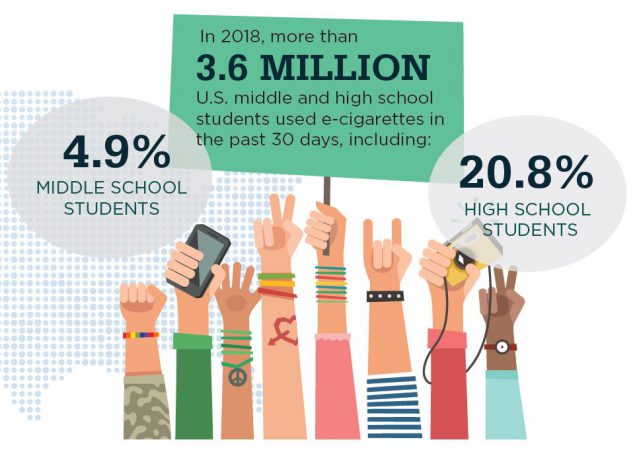
More information
- Guide for quitting smoking: Provides free resources, including a mobile app and quit guide.
- Federal regulation of e-cigarettes: Provides an overview of FDA regulations of e-cigarettes and other tobacco products.
- Information for parents, caregivers, and influencers of youth and young adults about e-cigarettes: Features comprehensive information about the impact of e-cigarette use among young people, and includes resources such as a tip sheet for parents to talk to their teens about e-cigarettes.
- Surgeon General’s Report on E-cigarette Use Among Youth and Young Adults [PDF–8.47 MB]: Released in 2016, this is the first report issued by a federal agency to comprehensively review the public health issue of e-cigarette use among youth and young adults. The report’s scientific findings are based on the best available evidence regarding a variety of topics, including trends in e-cigarette use; health effects of e-cigarettes, nicotine, and secondhand e-cigarette aerosol; e-cigarette marketing and advertising; and evidence-based strategies to reduce e-cigarette use among young people.
- State laws and policies regarding e-cigarettes: This CDC fact sheet reports on laws pertaining to sales, use, and taxation of e-cigarettes in the 50 states and the District of Columbia.
CDC has provided this material for your information. It is not intended to substitute for the medical expertise and advice of your primary health care provider. We encourage you to discuss any decisions about medication with your health care provider. The mention of any product, service, or therapy is not an endorsement by CDC.
Related Resources
References
- US Department of Health and Human Services. E-cigarette use among youth and young adults: a report of the Surgeon General [PDF–8.47 MB]. Atlanta, GA: US Department of Health and Human Services, CDC; 2016.
- Goniewicz ML, Gupta R, Lee YH, et al. Nicotine levels in electronic cigarette refill solutions: a comparative analysis of products from the U.S., Korea, and Poland. Int J Drug Policy. 2015;26(6):583–588.
- Patnode CP, Henderson JT, Thompson JH, Senger CA, Fortmann SP, Whitlock EP. Behavioral Counseling and Pharmacotherapy Interventions for Tobacco Cessation in Adults, Including Pregnant Women: A Review of Reviews for the U.S. Preventive Services Task Force. Evidence Synthesis No. 134. AHRQ Publication No. 14-05200-EF-1. Rockville, MD: Agency for Healthcare Research and Quality; 2015.
- Hartmann-Boyce J, McRobbie H, Bullen C, Begh R, Stead LF, Hajek P. Can electronic cigarettes help people stop smoking, and are they safe to use for this purpose? Published 13 September 2016.
- Caraballo RS, Shafer PR, Patel D, Davis KC, McAfee TA. Quit Methods Used by US Adult Cigarette Smokers, 2014–2016. Prev Chronic Dis 2017; 14:160600.
- Bjartveit K, Tverdal A. Health Consequences of Smoking 1-4 Cigarettes Per Day. Tobacco Control 2005;14(5):315–20.
- QuickStats: Cigarette Smoking Status Among Current Adult E-cigarette Users, by Age Group — National Health Interview Survey, United States, 2015. MMWR Morb Mortal Wkly Rep 2016;65:1177.
- Cullen KA, Ambrose BK, Gentzke A, et al. Notes from the Field: Increase in e-cigarette use and any tobacco product use among middle and high school students — United States, 2011-2018. MMWR Morb Mortal Wkly Rep 2018;68:1276-1277.
- Wang T, Asman K, Gentzke AS, et al. Tobacco Product Use Among Adults — United States, 2017. MMWR Morb Mortal Wkly Rep 2018;67:1225-1232
- Page last reviewed: November 15, 2018
- Page last updated: November 29, 2018
- Content source:


 ShareCompartir
ShareCompartir


